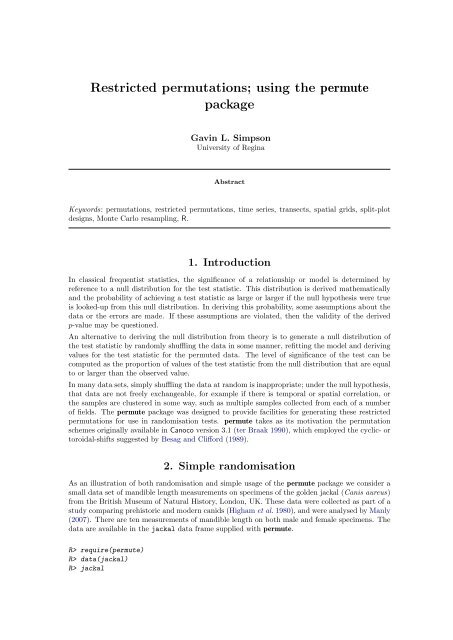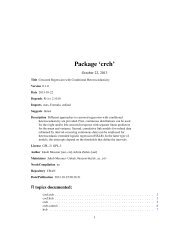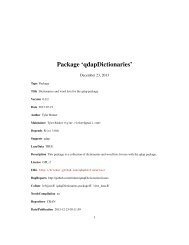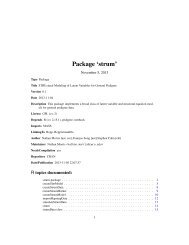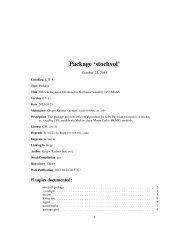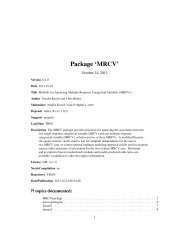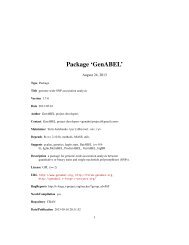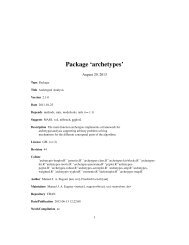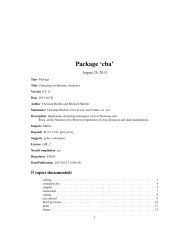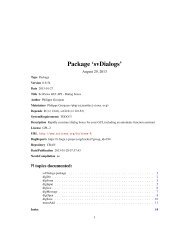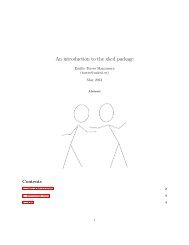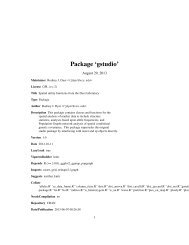Restricted permutations; using the permute package
Restricted permutations; using the permute package
Restricted permutations; using the permute package
You also want an ePaper? Increase the reach of your titles
YUMPU automatically turns print PDFs into web optimized ePapers that Google loves.
<strong>Restricted</strong> <strong>permutations</strong>; <strong>using</strong> <strong>the</strong> <strong>permute</strong><br />
<strong>package</strong><br />
Gavin L. Simpson<br />
University of Regina<br />
Abstract<br />
Keywords: <strong>permutations</strong>, restricted <strong>permutations</strong>, time series, transects, spatial grids, split-plot<br />
designs, Monte Carlo resampling, R.<br />
1. Introduction<br />
In classical frequentist statistics, <strong>the</strong> significance of a relationship or model is determined by<br />
reference to a null distribution for <strong>the</strong> test statistic. This distribution is derived ma<strong>the</strong>matically<br />
and <strong>the</strong> probability of achieving a test statistic as large or larger if <strong>the</strong> null hypo<strong>the</strong>sis were true<br />
is looked-up from this null distribution. In deriving this probability, some assumptions about <strong>the</strong><br />
data or <strong>the</strong> errors are made. If <strong>the</strong>se assumptions are violated, <strong>the</strong>n <strong>the</strong> validity of <strong>the</strong> derived<br />
p-value may be questioned.<br />
An alternative to deriving <strong>the</strong> null distribution from <strong>the</strong>ory is to generate a null distribution of<br />
<strong>the</strong> test statistic by randomly shuffling <strong>the</strong> data in some manner, refitting <strong>the</strong> model and deriving<br />
values for <strong>the</strong> test statistic for <strong>the</strong> <strong>permute</strong>d data. The level of significance of <strong>the</strong> test can be<br />
computed as <strong>the</strong> proportion of values of <strong>the</strong> test statistic from <strong>the</strong> null distribution that are equal<br />
to or larger than <strong>the</strong> observed value.<br />
In many data sets, simply shuffling <strong>the</strong> data at random is inappropriate; under <strong>the</strong> null hypo<strong>the</strong>sis,<br />
that data are not freely exchangeable, for example if <strong>the</strong>re is temporal or spatial correlation, or<br />
<strong>the</strong> samples are clustered in some way, such as multiple samples collected from each of a number<br />
of fields. The <strong>permute</strong> <strong>package</strong> was designed to provide facilities for generating <strong>the</strong>se restricted<br />
<strong>permutations</strong> for use in randomisation tests. <strong>permute</strong> takes as its motivation <strong>the</strong> permutation<br />
schemes originally available in Canoco version 3.1 (ter Braak 1990), which employed <strong>the</strong> cyclic- or<br />
toroidal-shifts suggested by Besag and Clifford (1989).<br />
2. Simple randomisation<br />
As an illustration of both randomisation and simple usage of <strong>the</strong> <strong>permute</strong> <strong>package</strong> we consider a<br />
small data set of mandible length measurements on specimens of <strong>the</strong> golden jackal (Canis aureus)<br />
from <strong>the</strong> British Museum of Natural History, London, UK. These data were collected as part of a<br />
study comparing prehistoric and modern canids (Higham et al. 1980), and were analysed by Manly<br />
(2007). There are ten measurements of mandible length on both male and female specimens. The<br />
data are available in <strong>the</strong> jackal data frame supplied with <strong>permute</strong>.<br />
R> require(<strong>permute</strong>)<br />
R> data(jackal)<br />
R> jackal
2 Using <strong>the</strong> <strong>permute</strong> <strong>package</strong><br />
Length Sex<br />
1 120 Male<br />
2 107 Male<br />
3 110 Male<br />
4 116 Male<br />
5 114 Male<br />
6 111 Male<br />
7 113 Male<br />
8 117 Male<br />
9 114 Male<br />
10 112 Male<br />
11 110 Female<br />
12 111 Female<br />
13 107 Female<br />
14 108 Female<br />
15 110 Female<br />
16 105 Female<br />
17 107 Female<br />
18 106 Female<br />
19 111 Female<br />
20 111 Female<br />
The interest is whe<strong>the</strong>r <strong>the</strong>re is a difference in <strong>the</strong> mean mandible length between male and female<br />
golden jackals. The null hypo<strong>the</strong>sis is that <strong>the</strong>re is zero difference in mandible length between <strong>the</strong><br />
two sexes or that females have larger mandibles. The alternative hypo<strong>the</strong>sis is that males have<br />
larger mandibles. The usual statistical test of this hypo<strong>the</strong>sis is a one-sided t test, which can be<br />
applied <strong>using</strong> t.test()<br />
R> jack.t jack.t<br />
Two Sample t-test<br />
data: Length by Sex<br />
t = 3.4843, df = 18, p-value = 0.001324<br />
alternative hypo<strong>the</strong>sis: true difference in means is greater than 0<br />
95 percent confidence interval:<br />
2.411156 Inf<br />
sample estimates:<br />
mean in group Male mean in group Female<br />
113.4 108.6<br />
The observed t is 3.484 with 18 df. The probability of observing a value this large or larger if <strong>the</strong><br />
null hypo<strong>the</strong>sis were true is 0.0013. Several assumptions have been made in deriving this p-value,<br />
namely<br />
1. random sampling of individuals from <strong>the</strong> populations of interest,<br />
2. equal population standard deviations for males and females, and<br />
3. that <strong>the</strong> mandible lengths are normally distributed within <strong>the</strong> sexes.<br />
Assumption 1 is unlikely to be valid for museum specimens such as <strong>the</strong>se, that have been collected<br />
in some unknown manner. Assumption 2 may be valid, Fisher’s F -test and a Fligner-Killeen test<br />
both suggest that <strong>the</strong> standard deviations of <strong>the</strong> two populations do not differ significantly
Gavin L. Simpson 3<br />
R> var.test(Length ~ Sex, data = jackal)<br />
F test to compare two variances<br />
data: Length by Sex<br />
F = 2.681, num df = 9, denom df = 9, p-value = 0.1579<br />
alternative hypo<strong>the</strong>sis: true ratio of variances is not equal to 1<br />
95 percent confidence interval:<br />
0.665931 10.793829<br />
sample estimates:<br />
ratio of variances<br />
2.681034<br />
R> fligner.test(Length ~ Sex, data = jackal)<br />
Fligner-Killeen test of homogeneity of variances<br />
data: Length by Sex<br />
Fligner-Killeen:med chi-squared = 0.7808, df = 1, p-value = 0.3769<br />
This assumption may be relaxed <strong>using</strong> var.equal = FALSE (<strong>the</strong> default) in <strong>the</strong> call to t.test(),<br />
to employ Welch’s modification for unequal variances. Assumption 3 may be valid, but with such<br />
a small sample we are unable to reliably test this.<br />
A randomisation test of <strong>the</strong> same hypo<strong>the</strong>sis can be performed by randomly allocating ten of <strong>the</strong><br />
mandible lengths to <strong>the</strong> male group and <strong>the</strong> remaining lengths to <strong>the</strong> female group. This randomisation<br />
is justified under <strong>the</strong> null hypo<strong>the</strong>sis because <strong>the</strong> observed difference in mean mandible<br />
length between <strong>the</strong> two sexes is just a typical value for <strong>the</strong> difference in a sample if <strong>the</strong>re were<br />
no difference in <strong>the</strong> population. An appropriate test statistic needs to be selected. We could use<br />
<strong>the</strong> t statistic as derived in <strong>the</strong> t-test. Alternatively, we could base our randomisation test on <strong>the</strong><br />
difference of means D i (male - female).<br />
The main function in <strong>permute</strong> for providing random <strong>permutations</strong> is shuffle(). We can write our<br />
own randomisation test for <strong>the</strong> jackal data by first creating a function to compute <strong>the</strong> difference<br />
of means for two groups<br />
R> meanDif Djackal N set.seed(42)<br />
R> for(i in seq_len(length(Djackal) - 1)) {<br />
+ perm
4 Using <strong>the</strong> <strong>permute</strong> <strong>package</strong><br />
The null distribution of D i can be visualised <strong>using</strong> a histogram, as shown in Figure 1. The observed<br />
difference of means (4.8) is indicated by <strong>the</strong> red tick mark.<br />
R> hist(Djackal, main = "",<br />
+ xlab = expression("Mean difference (Male - Female) in mm"))<br />
R> rug(Djackal[5000], col = "red", lwd = 2)<br />
The number of values in <strong>the</strong> randomisation distribution equal to or larger than <strong>the</strong> observed<br />
difference is<br />
R> (Dbig = Djackal[5000]))<br />
[1] 12<br />
giving a permutational p-value of<br />
R> Dbig / length(Djackal)<br />
[1] 0.0024<br />
which is comparable with that determined from <strong>the</strong> frequentist t-test, and indicates strong evidence<br />
against <strong>the</strong> null hypo<strong>the</strong>sis of no difference.<br />
In total <strong>the</strong>re 20 C 10 = 184, 756 possible allocations of <strong>the</strong> 20 observations to two groups of ten<br />
R> choose(20, 10)<br />
[1] 184756<br />
so we have only evaluated a small proportion of <strong>the</strong>se in <strong>the</strong> randomisation test.<br />
The main workhorse function we used above was shuffle(). In this example, we could have used<br />
<strong>the</strong> base R function sample() to generate <strong>the</strong> randomised indices perm that were used to <strong>permute</strong><br />
<strong>the</strong> Sex factor. Where shuffle() comes into it’s own is for generating permutation indices from<br />
restricted permutation designs.<br />
3. The shuffle() and shuffleSet() functions<br />
In <strong>the</strong> previous section I introduced <strong>the</strong> shuffle() function to generate permutation indices for<br />
use in a randomisation test. Now we will take a closer look at shuffle() and explore <strong>the</strong> various<br />
restricted permutation designs from which it can generate permutation indices.<br />
shuffle() has two arguments: i) n, <strong>the</strong> number of observations in <strong>the</strong> data set to be <strong>permute</strong>d,<br />
and ii) control, a list that defines <strong>the</strong> permutation design describing how <strong>the</strong> samples should be<br />
<strong>permute</strong>d.<br />
R> args(shuffle)<br />
function (n, control = how())<br />
NULL<br />
A series of convenience functions are provided that allow <strong>the</strong> user to set-up even quite complex<br />
permutation designs with little effort. The user only needs to specify <strong>the</strong> aspects of <strong>the</strong> design<br />
<strong>the</strong>y require and <strong>the</strong> convenience functions ensure all configuration choices are set and passed on<br />
to shuffle(). The main convenience function is how(), which returns a list specifying all <strong>the</strong><br />
options available for controlling <strong>the</strong> sorts of <strong>permutations</strong> returned by shuffle().
Gavin L. Simpson 5<br />
Frequency<br />
0 200 400 600 800 1000<br />
−6 −4 −2 0 2 4 6<br />
Mean difference (Male − Female) in mm<br />
Figure 1: Distribution of <strong>the</strong> difference of mean mandible length in random allocations, ten to<br />
each sex.<br />
R> str(how())<br />
List of 12<br />
$ within :List of 6<br />
..$ type : chr "free"<br />
..$ constant: logi FALSE<br />
..$ mirror : logi FALSE<br />
..$ ncol : NULL<br />
..$ nrow : NULL<br />
..$ call : language Within()<br />
..- attr(*, "class")= chr "Within"<br />
$ plots :List of 7<br />
..$ strata : NULL<br />
..$ type : chr "none"<br />
..$ mirror : logi FALSE<br />
..$ ncol : NULL<br />
..$ nrow : NULL<br />
..$ plots.name: chr "NULL"<br />
..$ call : language Plots()<br />
..- attr(*, "class")= chr "Plots"<br />
$ blocks : NULL
6 Using <strong>the</strong> <strong>permute</strong> <strong>package</strong><br />
$ nperm : num 199<br />
$ complete : logi FALSE<br />
$ maxperm : num 9999<br />
$ minperm : num 99<br />
$ all.perms : NULL<br />
$ make : logi TRUE<br />
$ observed : logi FALSE<br />
$ blocks.name: chr "NULL"<br />
$ call : language how()<br />
- attr(*, "class")= chr "how"<br />
The defaults describe a random permutation design where all objects are freely exchangeable.<br />
Using <strong>the</strong>se defaults, shuffle(10) amounts to sample(1:10, 10, replace = FALSE):<br />
R> set.seed(2)<br />
R> (r1 set.seed(2)<br />
R> (r2 all.equal(r1, r2)<br />
[1] TRUE<br />
3.1. Generating restricted <strong>permutations</strong><br />
Several types of permutation are available in <strong>permute</strong>:<br />
• Free permutation of objects<br />
• Time series or line transect designs, where <strong>the</strong> temporal or spatial ordering is preserved.<br />
• Spatial grid designs, where <strong>the</strong> spatial ordering is preserved in both coordinate directions<br />
• Permutation of plots or groups of samples.<br />
• Blocking factors which restrict <strong>permutations</strong> to within blocks. The preceding designs can be<br />
nested within blocks.<br />
The first three of <strong>the</strong>se can be nested within <strong>the</strong> levels of a factor or to <strong>the</strong> levels of that factor, or<br />
to both. Such flexibility allows <strong>the</strong> analysis of split-plot designs <strong>using</strong> permutation tests, especially<br />
when combined with blocks.<br />
how() is used to set up <strong>the</strong> design from which shuffle() will draw a permutation. how() has<br />
two main arguments that specify how samples are <strong>permute</strong>d within plots of samples or at <strong>the</strong> plot<br />
level itself. These are within and plots. Two convenience functions, Within() and Plots() can<br />
be used to set <strong>the</strong> various options for permutation. Blocks operate at <strong>the</strong> uppermost level of this<br />
hierarchy; blocks define groups of plots, each of which may contain groups of samples.<br />
For example, to <strong>permute</strong> <strong>the</strong> observations 1:10 assuming a time series design for <strong>the</strong> entire set of<br />
observations, <strong>the</strong> following control object would be used
Gavin L. Simpson 7<br />
R> set.seed(4)<br />
R> x CTRL perm perm<br />
[1] 7 8 9 10 1 2 3 4 5 6<br />
R> x[perm] ## equivalent<br />
[1] 7 8 9 10 1 2 3 4 5 6<br />
It is assumed that <strong>the</strong> observations are in temporal or transect order. We only specified <strong>the</strong> type<br />
of permutation within plots, <strong>the</strong> remaining options were set to <strong>the</strong>ir defaults via Within().<br />
A more complex design, with three plots, and a 3 by 3 spatial grid arrangement within each plot<br />
can be created as follows<br />
R> set.seed(4)<br />
R> plt CTRL perm perm<br />
[1] 6 4 5 9 7 8 3 1 2 14 15 13 17 18 16 11 12 10 22 23 24 25 26 27 19<br />
[26] 20 21<br />
Visualising <strong>the</strong> permutation as <strong>the</strong> 3 matrices may help illustrate how <strong>the</strong> data have been shuffled<br />
R> ## Original<br />
R> lapply(split(seq_along(plt), plt), matrix, ncol = 3)<br />
$‘1‘<br />
[,1] [,2] [,3]<br />
[1,] 1 4 7<br />
[2,] 2 5 8<br />
[3,] 3 6 9<br />
$‘2‘<br />
[,1] [,2] [,3]<br />
[1,] 10 13 16<br />
[2,] 11 14 17<br />
[3,] 12 15 18<br />
$‘3‘<br />
[,1] [,2] [,3]<br />
[1,] 19 22 25<br />
[2,] 20 23 26<br />
[3,] 21 24 27<br />
R> ## Shuffled<br />
R> lapply(split(perm, plt), matrix, ncol = 3)
8 Using <strong>the</strong> <strong>permute</strong> <strong>package</strong><br />
$‘1‘<br />
[,1] [,2] [,3]<br />
[1,] 6 9 3<br />
[2,] 4 7 1<br />
[3,] 5 8 2<br />
$‘2‘<br />
[,1] [,2] [,3]<br />
[1,] 14 17 11<br />
[2,] 15 18 12<br />
[3,] 13 16 10<br />
$‘3‘<br />
[,1] [,2] [,3]<br />
[1,] 22 25 19<br />
[2,] 23 26 20<br />
[3,] 24 27 21<br />
In <strong>the</strong> first grid, <strong>the</strong> lower-left corner of <strong>the</strong> grid was set to row 2 and column 2 of <strong>the</strong> original, to<br />
row 1 and column 2 in <strong>the</strong> second grid, and to row 3 column 2 in <strong>the</strong> third grid.<br />
To have <strong>the</strong> same permutation within each level of plt, use <strong>the</strong> constant argument of <strong>the</strong> Within()<br />
function, setting it to TRUE<br />
R> set.seed(4)<br />
R> CTRL perm2 lapply(split(perm2, plt), matrix, ncol = 3)<br />
$‘1‘<br />
[,1] [,2] [,3]<br />
[1,] 6 9 3<br />
[2,] 4 7 1<br />
[3,] 5 8 2<br />
$‘2‘<br />
[,1] [,2] [,3]<br />
[1,] 15 18 12<br />
[2,] 13 16 10<br />
[3,] 14 17 11<br />
$‘3‘<br />
[,1] [,2] [,3]<br />
[1,] 24 27 21<br />
[2,] 22 25 19<br />
[3,] 23 26 20<br />
3.2. Generating sets of <strong>permutations</strong> with shuffleSet()<br />
There are several reasons why one might wish to generate a set of n <strong>permutations</strong> instead of<br />
repeatedly generating <strong>permutations</strong> one at a time. Interpreting <strong>the</strong> permutation design happens<br />
each time shuffle() is called. This is an unnecessary computational burden, especially if you want
Gavin L. Simpson 9<br />
to perform tests with large numbers of <strong>permutations</strong>. Fur<strong>the</strong>rmore, having <strong>the</strong> set of <strong>permutations</strong><br />
available allows for expedited use with o<strong>the</strong>r functions, <strong>the</strong>y can be iterated over <strong>using</strong> for loops<br />
or <strong>the</strong> apply family of functions, and <strong>the</strong> set of <strong>permutations</strong> can be exported for use outside of<br />
R.<br />
The shuffleSet() function allows <strong>the</strong> generation of sets of <strong>permutations</strong> from any of <strong>the</strong> designs<br />
available in <strong>permute</strong>. shuffleSet() takes an additional argument to that of shuffle(), nset,<br />
which is <strong>the</strong> number of <strong>permutations</strong> required for <strong>the</strong> set. nset can be missing, in which case<br />
<strong>the</strong> number of <strong>permutations</strong> in <strong>the</strong> set is looked for in <strong>the</strong> object passed to control; <strong>using</strong> this,<br />
<strong>the</strong> desired number of <strong>permutations</strong> can be set at <strong>the</strong> time <strong>the</strong> design is created via <strong>the</strong> nperm<br />
argument of how(). For example,<br />
R> how(nperm = 10, within = Within(type = "series"))<br />
Internally, shuffle() and shuffleSet() are very similar, with <strong>the</strong> major difference being that<br />
shuffleSet() arranges repeated calls to <strong>the</strong> workhorse permutation-generating functions, only<br />
incurring <strong>the</strong> overhead associated with interpreting <strong>the</strong> permutation design once. shuffleSet()<br />
returns a matrix where <strong>the</strong> rows represent different <strong>permutations</strong> in <strong>the</strong> set.<br />
As an illustration, consider again <strong>the</strong> simple time series example from earlier. Here I generate a<br />
set of 5 <strong>permutations</strong> from <strong>the</strong> design, with <strong>the</strong> results returned as a matrix<br />
R> set.seed(4)<br />
R> CTRL pset pset<br />
No. of Permutations: 5<br />
No. of Samples: 10 (Nested in: plots; Sequence)<br />
[,1] [,2] [,3] [,4] [,5] [,6] [,7] [,8] [,9] [,10]<br />
[1,] 7 8 9 10 1 2 3 4 5 6<br />
[2,] 2 3 4 5 6 7 8 9 10 1<br />
[3,] 4 5 6 7 8 9 10 1 2 3<br />
[4,] 3 4 5 6 7 8 9 10 1 2<br />
[5,] 6 7 8 9 10 1 2 3 4 5<br />
It is worth taking a moment to explain what has happened here, behind <strong>the</strong> scenes. There are<br />
only 10 unique orderings (including <strong>the</strong> observed) in <strong>the</strong> set of <strong>permutations</strong> for this design. Such<br />
a small set of <strong>permutations</strong> triggers 1 <strong>the</strong> generation of <strong>the</strong> entire set of <strong>permutations</strong>. From this<br />
set, shuffleSet() samples at random nset <strong>permutations</strong>. Hence <strong>the</strong> same number of random<br />
values has been generated via <strong>the</strong> pseudo-random number generator in R but we ensure a set of<br />
unique <strong>permutations</strong> is drawn, ra<strong>the</strong>r than randomly sample from a small set.<br />
4. Defining permutation designs<br />
In this section I give examples how various permutation designs can be specified <strong>using</strong> how(). It<br />
is not <strong>the</strong> intention to provide exhaustive coverage of all possible designs that can be produced;<br />
such a list would be tedious to both write and read. Instead, <strong>the</strong> main features and options will<br />
be described through a series of examples. The reader should <strong>the</strong>n be able to put toge<strong>the</strong>r <strong>the</strong><br />
various options to create <strong>the</strong> exact structure required.<br />
1 The trigger is via <strong>the</strong> utility function check(), which calls ano<strong>the</strong>r utility function, allPerms(), to generate <strong>the</strong><br />
set of <strong>permutations</strong> for <strong>the</strong> stated design. The trigger for complete enumeration is set via how() <strong>using</strong> argument<br />
minperm; below this value, by default check() will generate <strong>the</strong> entire set of <strong>permutations</strong>.
10 Using <strong>the</strong> <strong>permute</strong> <strong>package</strong><br />
4.1. Set <strong>the</strong> number of <strong>permutations</strong><br />
It may be useful to specify <strong>the</strong> number of <strong>permutations</strong> required in a permutation test alongside<br />
<strong>the</strong> permutation design. This is done via <strong>the</strong> nperm argument, as seen earlier. If nothing else is<br />
specified<br />
R> how(nperm = 999)<br />
would indicate 999 random <strong>permutations</strong> where <strong>the</strong> samples are all freely exchangeable.<br />
One advantage of <strong>using</strong> nperm is that shuffleSet() will use this if <strong>the</strong> nset argument is not<br />
specified. Additionally, shuffleSet() will check to see if <strong>the</strong> desired number of <strong>permutations</strong> is<br />
possible given <strong>the</strong> data and <strong>the</strong> requested design. This is done via <strong>the</strong> function check(), which is<br />
discussed later.<br />
4.2. The levels of <strong>the</strong> permutation hierarchy<br />
There are three levels at which <strong>permutations</strong> can be controlled in <strong>permute</strong>. The highest level of<br />
<strong>the</strong> hierarchy is <strong>the</strong> block level. Blocks are defined by a factor variable. Blocks restrict permutation<br />
of samples to within <strong>the</strong> levels of this factor; samples are never swapped between blocks.<br />
The plot level sits below blocks. Plots are defined by a factor and group samples in <strong>the</strong> same way<br />
as blocks. As such, some permutation designs can be initiated <strong>using</strong> a factor at <strong>the</strong> plot level or<br />
<strong>the</strong> same factor at <strong>the</strong> block level. The major difference between blocks and plots is that plots<br />
can also be <strong>permute</strong>d, whereas blocks are never <strong>permute</strong>d.<br />
The lowest level of a permutation design in <strong>the</strong> <strong>permute</strong> hierarchy is known as within, and refers<br />
to samples nested within plots. If <strong>the</strong>re are no plots or blocks, how samples are <strong>permute</strong>d at <strong>the</strong><br />
within level applies to <strong>the</strong> entire data set.<br />
4.2.1. Permuting samples at <strong>the</strong> lowest level<br />
How samples at <strong>the</strong> within level are <strong>permute</strong>d is configured <strong>using</strong> <strong>the</strong> Within() function. It takes<br />
<strong>the</strong> following arguments<br />
function (type = c("free", "series", "grid", "none"), constant = FALSE,<br />
mirror = FALSE, ncol = NULL, nrow = NULL)<br />
NULL<br />
type controls how <strong>the</strong> samples at <strong>the</strong> lowest level are <strong>permute</strong>d. The default is to form unrestricted<br />
<strong>permutations</strong> via option "type". Options "series" and "grid" form restricted<br />
<strong>permutations</strong> via cyclic or toroidal shifts, respectively. The former is useful for samples<br />
that are a time series or line-transect, whilst <strong>the</strong> latter is used for samples on a regular<br />
spatial grid. The final option, "none", will result in <strong>the</strong> samples at <strong>the</strong> lowest level not<br />
being <strong>permute</strong>d at all. This option is only of practical use when <strong>the</strong>re are plots within <strong>the</strong><br />
permutation/experimental design 2 .<br />
constant this argument only has an effect when <strong>the</strong>re are plots in <strong>the</strong> design 3 . constant =<br />
FALSE, stipulates that each plot should have <strong>the</strong> same within-plot permutation. This is<br />
useful when you have time series of observations from several plots. If all plots were sampled<br />
at <strong>the</strong> same time points, it can be argued that at <strong>the</strong> plot level, <strong>the</strong> samples experienced <strong>the</strong><br />
same time and hence <strong>the</strong> same permutation should be used within each plot.<br />
mirror when type is "series" or "grid", argument "mirror" controls whe<strong>the</strong>r <strong>permutations</strong><br />
are taken from <strong>the</strong> mirror image of <strong>the</strong> observed ordering in space or time. Consider <strong>the</strong><br />
2 As blocks are never <strong>permute</strong>d, <strong>using</strong> type = "none" at <strong>the</strong> within level is also of no practical use.<br />
3 Owing to <strong>the</strong> current implementation, whilst this option could also be useful when blocks to define groups of<br />
samples, it will not have any influence over how <strong>permutations</strong> are generated. As such, only use blocks for simple<br />
blocking structures and use plots if you require greater control of <strong>the</strong> <strong>permutations</strong> at <strong>the</strong> group (i.e. plot) level.
Gavin L. Simpson 11<br />
sequence 1, 2, 3, 4. The relationship between observations is also preserved if we reverse<br />
<strong>the</strong> original ordering to 4, 3, 2, 1 and generate <strong>permutations</strong> from both <strong>the</strong>se orderings.<br />
This is what happens when mirror = TRUE. For time series, <strong>the</strong> reversed ordering 4, 3,<br />
2, 1 would imply an influence of observation 4 on observation 3, which is implausible. For<br />
spatial grids or line transects, however, this is a sensible option, and can significantly increase<br />
<strong>the</strong> number of possible <strong>permutations</strong> 4 .<br />
ncol, nrow define <strong>the</strong> dimensions of <strong>the</strong> spatial grid.<br />
How Within() is used has already been encountered in earlier sections of this vignette; <strong>the</strong> function<br />
is used to supply a value to <strong>the</strong> within argument of how(). You may have noticed that all <strong>the</strong><br />
arguments of Within() have default values? This means that <strong>the</strong> user need only supply a modified<br />
value for <strong>the</strong> arguments <strong>the</strong>y wish to change. Also, arguments that are not relevant for <strong>the</strong> type<br />
of permutation stated are simply ignored; nrow and ncol, for example, could be set to any value<br />
without affecting <strong>the</strong> permutation design if type != "grid" 5 .<br />
4.2.2. Permuting samples at <strong>the</strong> Plot level<br />
Permutation of samples at <strong>the</strong> plot level is configured via <strong>the</strong> Plots() function. As with Within(),<br />
Plots() is supplied to <strong>the</strong> plots argument of how(). Plots() takes many of <strong>the</strong> same arguments<br />
as Within(), <strong>the</strong> two differences being strata, a factor variable that describes <strong>the</strong> grouping of<br />
samples at <strong>the</strong> plot level, and <strong>the</strong> absence of a constant argument. As <strong>the</strong> majority of arguments<br />
are similar between Within() and Plots(), I will not repeat <strong>the</strong> details again, and only describe<br />
<strong>the</strong> strata argument<br />
strata a factor variable. strata describes <strong>the</strong> grouping of samples at <strong>the</strong> plot level, where samples<br />
from <strong>the</strong> same plot are take <strong>the</strong> same level of <strong>the</strong> factor.<br />
When a plot-level design is specified, samples are never <strong>permute</strong>d between plots, only within plots<br />
if <strong>the</strong>y are <strong>permute</strong>d at all. Hence, <strong>the</strong> type of permutation within <strong>the</strong> plots is controlled by<br />
Within(). Note also that with Plots(), <strong>the</strong> way <strong>the</strong> individual plots are <strong>permute</strong>d can be from<br />
any one of <strong>the</strong> four basic permutation types; "none", "free", "series", and "grid", as described<br />
above. To <strong>permute</strong> <strong>the</strong> plots only (i.e. retain <strong>the</strong> ordering of <strong>the</strong> samples within plots), you also<br />
need to specify Within(type = "none", ...) as <strong>the</strong> default in Within() is type = "free".<br />
The ability to <strong>permute</strong> <strong>the</strong> plots whilst preserving <strong>the</strong> within-plot ordering is an impotant feature<br />
in testing explanatory factors at <strong>the</strong> whole-plot level in split-plot designs and in multifactorial<br />
analysis of variance (ter Braak and Šmilauer 2012).<br />
4.2.3. Specifying blocks; <strong>the</strong> top of <strong>the</strong> <strong>permute</strong> hierarchy<br />
In constrast to <strong>the</strong> within and plots levels, <strong>the</strong> blocks level is simple to specify; all that is required<br />
is an indicator variable <strong>the</strong> same length as <strong>the</strong> data. Usually this is a factor, but how() will take<br />
anything that can be coerced to a factor via as.factor().<br />
It is worth repeating what <strong>the</strong> role of <strong>the</strong> block-level structure is; blocks simply restrict permutation<br />
to within, and never between, blocks, and blocks are never <strong>permute</strong>d. This is reflected in <strong>the</strong><br />
implementation; <strong>the</strong> split-apply-combine paradigm is used to split on <strong>the</strong> blocking factor, <strong>the</strong><br />
plot- and within-level permutation design is applied separately to each block, and finally <strong>the</strong> sets<br />
of <strong>permutations</strong> for each block are recombined.<br />
4.3. Examples<br />
To do.<br />
4 Setting mirror = TRUE will double or quadruple <strong>the</strong> set of <strong>permutations</strong> for "series" or "grid" <strong>permutations</strong>,<br />
respectively, as long as <strong>the</strong>re are more than two time points or columns in <strong>the</strong> grid.<br />
5 No warnings are currently given if incompatible arguments are specified; <strong>the</strong>y are ignored, but may show up in<br />
<strong>the</strong> printed output. This infelicity will be removed prior to <strong>permute</strong> version 1.0-0 being released.
12 Using <strong>the</strong> <strong>permute</strong> <strong>package</strong><br />
5. Using <strong>permute</strong> in R functions<br />
<strong>permute</strong> originally started life as a set of functions contained within <strong>the</strong> vegan <strong>package</strong> (Oksanen<br />
et al. 2013) designed to provide a replacement for <strong>the</strong> <strong>permute</strong>d.index() function. From <strong>the</strong>se<br />
humble origins, I realised o<strong>the</strong>r users and <strong>package</strong> authors might want to make use of <strong>the</strong> code I<br />
was writing and so Jari oksanen, <strong>the</strong> maintainer of vegan, and I decided to spin off <strong>the</strong> code into<br />
<strong>the</strong> <strong>permute</strong> <strong>package</strong>. Hence from <strong>the</strong> very beginning, <strong>permute</strong> was intended for use both by users,<br />
to defining permutation designs, and by <strong>package</strong> authors, with which to implement permutation<br />
tests within <strong>the</strong>ir <strong>package</strong>s.<br />
In <strong>the</strong> previous sections, I described <strong>the</strong> various user-facing functions that are employed to set<br />
up permutation designs and generate <strong>permutations</strong> from <strong>the</strong>se. Here I will outline how <strong>package</strong><br />
authors can use functionality in <strong>the</strong> <strong>permute</strong> <strong>package</strong> to implement permutation tests.<br />
In Section 2 I showed how a permutation test function could be written <strong>using</strong> <strong>the</strong> shuffle()<br />
function and allowing <strong>the</strong> user to pass into <strong>the</strong> test function an object created with how(). As<br />
mentioned earlier, it is more efficient to generate a set of <strong>permutations</strong> via a call to shuffleSet()<br />
than to repeatedly call shuffle() and large number of times. Ano<strong>the</strong>r advantage of <strong>using</strong><br />
shuffleSet() is that once <strong>the</strong> set of <strong>permutations</strong> has been created, parallel processing can<br />
be used to break <strong>the</strong> set of <strong>permutations</strong> down into smaller chunks, each of which can be worked<br />
on simultaneously. As a result, <strong>package</strong> authors are encouraged to use shuffleSet() instead of<br />
<strong>the</strong> simpler shuffle().<br />
To illustrate how to use <strong>permute</strong> in R functions, I’ll rework <strong>the</strong> permutation test I used for <strong>the</strong><br />
jackal data earlier in Section 2.<br />
pt.test
Gavin L. Simpson 13<br />
[1] 0.0024<br />
which nicely agrees with <strong>the</strong> test we did earlier by hand.<br />
Iterating over a set of permutation indices also means that adding parallel processing of <strong>the</strong><br />
<strong>permutations</strong> requires only trivial changes to <strong>the</strong> main function code. As an illustration, below I<br />
show a parallel version of pt.test()<br />
ppt.test
14 Using <strong>the</strong> <strong>permute</strong> <strong>package</strong><br />
user system elapsed<br />
1.966 0.005 1.983<br />
R> ppval2<br />
[1] 0.002<br />
The cost of setting up and managing <strong>the</strong> parallel processes, and recombining <strong>the</strong> separate sets<br />
of results almost negates <strong>the</strong> gain in running <strong>the</strong> <strong>permutations</strong> in parallel. Here, <strong>the</strong> computations<br />
involved in meanDif() are trivial and we would expect greater efficiencies from running <strong>the</strong><br />
<strong>permutations</strong> in parallel for more complex analyses.<br />
5.1. Accesing and changing permutation designs<br />
Th object created by how() is a relatively simple list containing <strong>the</strong> settings for <strong>the</strong> specified<br />
permutation design. As such one could use <strong>the</strong> standard subsetting and replacement functions<br />
in base R to alter components of <strong>the</strong> list. This is not recommended, however, as <strong>the</strong> internal<br />
structure of <strong>the</strong> list returned by how() may change in a later version of <strong>permute</strong>. Fur<strong>the</strong>rmore, to<br />
facilitate <strong>the</strong> use of update() at <strong>the</strong> user-level to alter <strong>the</strong> permutation design in a user-friendly<br />
way, <strong>the</strong> matched how() call is stored within <strong>the</strong> list along with <strong>the</strong> matched calls for any Within()<br />
or Plots() components. These matched calls need to be updated too if <strong>the</strong> list describing <strong>the</strong><br />
permutation design is altered. To allow function writers to access and alter permutation designs,<br />
<strong>permute</strong> provides a series of extractor and replacement functions that have <strong>the</strong> forms getFoo()<br />
and setFoo
Gavin L. Simpson 15<br />
getObserved() returns a logical, which indicates whe<strong>the</strong>r <strong>the</strong> observed permutation (ordering of<br />
samples) is included in <strong>the</strong> entire set of permutation generated by allPerms().<br />
getAllperms() extracts <strong>the</strong> complete set of <strong>permutations</strong> if present. Returns NULL if <strong>the</strong> set has<br />
not been generated.<br />
The available setFoo()
16 Using <strong>the</strong> <strong>permute</strong> <strong>package</strong><br />
R> hh getNperm(hh)<br />
[1] 199<br />
The corresponding replacement function can be use to alter <strong>the</strong> number of <strong>permutations</strong> after<br />
<strong>the</strong> design has been generated. To illustrate a finer point of <strong>the</strong> behaviour of <strong>the</strong>se replacement<br />
functions, compare <strong>the</strong> matched call stored in hh before and after <strong>the</strong> number of <strong>permutations</strong> is<br />
changed<br />
R> getCall(hh)<br />
how()<br />
R> setNperm(hh) getNperm(hh)<br />
[1] 999<br />
R> getCall(hh)<br />
how(nperm = 999)<br />
Note how <strong>the</strong> call component has been altered to include <strong>the</strong> argument pair nperm = 999, hence<br />
if this call were evaluated, <strong>the</strong> resulting object would be a copy of hh.<br />
As a more complex example, consider <strong>the</strong> following design consisting of 5 blocks, each containing<br />
2 plots of 5 samples each. Hence <strong>the</strong>re are a total of 10 plots. Both <strong>the</strong> plots and within-plot<br />
sample are time series. This design can be created <strong>using</strong><br />
R> hh pl setType(pl) setPlots(hh) getType(hh, which = "plots")<br />
[1] "free"<br />
Notice too how <strong>the</strong> call has been expanded from gl(10, 5) to an integer vector. This expansion<br />
is to avoid <strong>the</strong> obvious problem of locating <strong>the</strong> objects referred to in <strong>the</strong> call should <strong>the</strong> call be<br />
re-evaluated later.
Gavin L. Simpson 17<br />
R> getCall(getPlots(hh))<br />
Plots(strata = c(1L, 1L, 1L, 1L, 1L, 2L, 2L, 2L, 2L, 2L, 3L,<br />
3L, 3L, 3L, 3L, 4L, 4L, 4L, 4L, 4L, 5L, 5L, 5L, 5L, 5L, 6L, 6L,<br />
6L, 6L, 6L, 7L, 7L, 7L, 7L, 7L, 8L, 8L, 8L, 8L, 8L, 9L, 9L, 9L,<br />
9L, 9L, 10L, 10L, 10L, 10L, 10L), type = "free")<br />
At <strong>the</strong> top level, a user can update <strong>the</strong> design <strong>using</strong> update(). Hence <strong>the</strong> equivalent of <strong>the</strong> above<br />
update is (this time resetting <strong>the</strong> original type; type = "series")<br />
R> hh getType(hh, which = "plots")<br />
[1] "series"<br />
However, this approach is not assured of working within a function because we do not guarantee<br />
that components of <strong>the</strong> call used to create hh can be found from <strong>the</strong> execution frame where<br />
update() is called. To be safe, always use <strong>the</strong> setFoo


